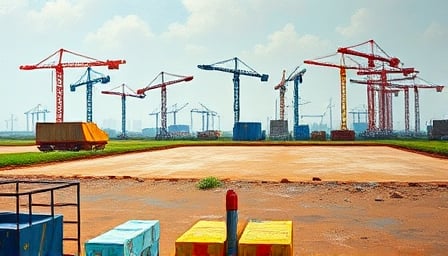St. Joe Co: A Real Estate Giant Under Scrutiny
In the ever-evolving landscape of the real estate sector, St. Joe Co stands as a formidable entity, yet not without its share of controversies and challenges. Based in Watersound, United States, this real estate operating company has carved a niche for itself through its diverse operations, which span real estate development, asset management, and sales, alongside a significant stake in the timber industry. However, recent financial indicators and market performance raise questions about its future trajectory and strategic decisions.
As of July 17, 2025, St. Joe Co’s stock closed at $49.46 on the New York Stock Exchange, a figure that, while respectable, falls short of its 52-week high of $64.69 recorded on July 25, 2024. This decline is not just a number but a reflection of the volatile nature of the real estate market and possibly, the company’s strategic missteps. The 52-week low of $40.19, observed on April 8, 2025, further underscores the financial turbulence the company has navigated over the past year.
With a market capitalization of $2.91 billion, St. Joe Co is undeniably a heavyweight in the real estate sector. However, its price-to-earnings ratio of 37.46 suggests a valuation that might be stretching the limits of investor patience and confidence. This ratio, significantly higher than the industry average, raises critical questions about the company’s growth prospects and its ability to justify such a premium valuation.
The company’s dual focus on real estate and timber presents a unique blend of opportunities and risks. While the timber industry offers a stable revenue stream, it is not immune to the environmental and regulatory challenges that have become increasingly prevalent. The real estate sector, on the other hand, is subject to market fluctuations and economic cycles, making it a high-stakes game of timing and strategy.
Strategic Missteps and Market Challenges
The decline in St. Joe Co’s stock price over the past year can be attributed to several factors, both internal and external. Internally, questions have been raised about the company’s strategic direction, particularly its ability to balance its real estate and timber operations effectively. Externally, the broader economic environment, characterized by fluctuating interest rates and uncertain economic growth forecasts, has undoubtedly played a role.
Moreover, the company’s ambitious expansion plans have been met with skepticism. Critics argue that St. Joe Co’s aggressive growth strategy, particularly in new and untested markets, may be overreaching, potentially exposing the company to significant financial risk.
Looking Ahead: A Crossroads for St. Joe Co
As St. Joe Co stands at this critical juncture, the path forward is fraught with challenges. The company must navigate the delicate balance between growth and sustainability, ensuring that its expansion efforts do not compromise its financial stability or environmental responsibilities.
Investors and stakeholders are watching closely, seeking reassurance that St. Joe Co can adapt to the changing market dynamics and regulatory landscape. The company’s ability to innovate, streamline operations, and perhaps most importantly, make strategic adjustments in response to market feedback, will be crucial in determining its future success.
In conclusion, while St. Joe Co remains a significant player in the real estate sector, its recent performance and strategic decisions have cast a shadow of uncertainty over its future. The coming months will be critical in shaping the company’s trajectory, with the potential to either reaffirm its status as a real estate powerhouse or serve as a cautionary tale of ambition outpacing prudence.
